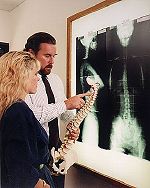|
A. X-rays
are a very important part of the diagnostic process in determining the
possible cause of your health problems. They are one of the many tools
a chiropractor may use to evaluate your condition. Additionally, the
consultation and examination may include orthopedic and neurological
testing, and specific chiropractic testing may be done.
In
our clinic we x-ray most of our patients, with the exception of very
young children and pregnant women. We usually only have to take two
x-rays, one from the front and one from the side. As a rule we want
to see x-rays of our patients before we treat them.
The
x-rays give us a vast amount of information that is very useful in the
diagnosis and treatment of the patient. It is questionable why some
chiropractors don't x-ray before treating a patient.
One
of the main reasons to s-ray is to specifically locate and analyze the
subluxation. Remember, a subluxation is a misalignment of the vertebrae
in your spine which results in pressure on your nervous system. This
pressure on your nerves will result in a lack of normal function of
those nerves. Eventually the abnormally functioning nerves will result
in a symptom such as pain, or lack of normal function of an organ such
as the liver or kidneys. Many times these subluxations have no symptoms,
and the only way to find them is with the proper x-rays.
It
is very common for a patient to come in with a pain in the lower back.
After taking x-rays, we find that they actually have a much worse problem
in their neck that they didn't even know they had because there were
no symptoms in that area.
Once
we have the x-ray, we analyze it according to the Gonstead technique.
This is a very specific technique which locates the subluxation and
then treats it. We find that by being this specific conditions which
were not responsive to other approaches can be treated successfully.
Other
important information that can be gained from x-rays is the presence
of any abnormalities. These may include variations in the way the spine
has developed -- which is very common. We may also find fractures, pathology
such as cancer, abnormal curves, or degenerative changes.
As
the spine ages it goes through degenerative changes. The rate of degeneration
is directly related to the amount of misalignment in the spine. In other
words, the more severe the subluxations, the faster the spine will degenerate.
Determining
the phase of degeneration that your spine is in (1, 2, 3, or 4) is crucial
to the way we approach your case. It is also important in projecting
your prognosis and the time it will take for you to heal.
In
conclusion, I think the best way to sum it up is on a sign that hangs
in our x-ray department. It says:
Why
chiropractic x-rays?
To see is to know.
Not to see is to guess.
And we won't guess
About your health.
|


